The Observation of Traveling Ionospheric Disturbances Using the Sanya Incoherent Scatter Radar
Abstract
:1. Introduction
2. Geomagnetic Activity
3. Materials and Methods
4. Results
4.1. Result from SYISR
4.2. Result from GNSS TEC
4.3. Result from Ionosonde
5. Discussion
6. Conclusions
- The two LSTID events exhibit similar yet distinct vertical propagation characteristics. Both events were identified with a dominant period of ~110–155 min and downward vertical phase velocities ranging from 22 m/s to 60 m/s. Their amplitudes continuously increase with increasing altitude and then gradually decrease after reaching their peak at 200–250 km. Additionally, a phase anomaly in the vertical direction of this TID was observed, a phenomenon different from the AGW theory. The first phase of the first LSTID event shows a characteristic with a more vertical phase than the second phase front in the 350–510 km altitude range. This anomaly is likely attributed to the combined effect of sunrise and pre-sunrise uplift. These drastic changes in electron density after sunrise caused a TID-like phase reversal in the filtered phase.
- The different propagation features of the two LSTIDs suggest different sources. The first LSTID event was observed with a relative amplitude of 18–25% at altitudes ranging from 170 km to 700 km. The combined observation of the GNSS network and SYISR showed that the first LSTID originated from the high latitudes of the Asian sector, propagated across East Asia, and then reached Sanya. A smaller estimated elevation angle (~3°–4°) supports the long-distance propagation of the first LSTID. On the other hand, the second LSTID, not detected by GNSS in mainland China and Japan, displayed a smaller amplitude (~17–20%) and lower propagation altitude (150–360 km). The larger estimated elevation angle (~17°) implies that the second LSTID was likely triggered by a local source.
- The periodic MSTID event may be associated with lower atmospheric AGWs. This MSTID event occurred in the lower ionosphere (130–210 km) above Es. Although a notable maximum amplitude of ~29–36% was observed at ~130 km altitude, this TID event dissipated rapidly during its upward propagation at a rate of approximately −1.11%/km.
Author Contributions
Funding
Data Availability Statement
Conflicts of Interest
References
- Hajkowicz, L.A. Auroral electrojet effect on the global occurrence pattern of large-scale traveling ionospheric disturbances. Planet. Space Sci. 1991, 39, 1189–1196. [Google Scholar] [CrossRef]
- Ding, F.; Wan, W.; Liu, L.; Afraimovich, E.L.; Voeykov, S.V.; Perevalova, N.P. A statistical study of large-scale traveling ionospheric disturbances observed by GPS TEC during major magnetic storms over the years 2003–2005. J. Geophys. Res. Space Phys. 2008, 113, e2008ja013037. [Google Scholar] [CrossRef]
- Liu, J.; Zhang, D.H.; Coster, A.J.; Zhang, S.R.; Ma, G.Y.; Hao, Y.Q.; Xiao, Z. A case study of the large-scale traveling ionospheric disturbances in the eastern Asian sector during the 2015 St. Patrick’s Day geomagnetic storm. Ann. Geophys. 2019, 37, 673–687. [Google Scholar] [CrossRef]
- Unnikrishnan, K.; Saito, A.; Otsuka, Y.; Yamamoto, M.; Fukao, S. Transition region of TEC enhancement phenomena during geomagnetically disturbed periods at mid-latitudes. Ann. Geophys. 2005, 23, 3439–3450. [Google Scholar] [CrossRef]
- Yeh, K.C.; Liu, C.H.; Youakim, M.Y. Attenuation of internal gravity-waves in model atmospheres. Ann. Geophys. 1975, 31, 321–328. [Google Scholar]
- Tsugawa, T.; Saito, A.; Otsuka, Y. A statistical study of large-scale traveling ionospheric disturbances using the GPS network in Japan. J. Geophys. Res. Space Phys. 2004, 109, e2003ja010302. [Google Scholar] [CrossRef]
- Ding, F.; Wan, W.; Ning, B.; Zhao, B.; Li, Q.; Zhang, R.; Xiong, B.; Song, Q. Two-dimensional imaging of large-scale traveling ionospheric disturbances over China based on GPS data. J. Geophys. Res. Space Phys. 2012, 117, e2012ja017546. [Google Scholar] [CrossRef]
- Liu, C.H.; Yeh, K.C. Effect of ion drag on propagation of acoustic-gravity waves in the atmosphericFregion. J. Geophys. Res. 1969, 74, 2248–2255. [Google Scholar] [CrossRef]
- Song, Q.; Ding, F.; Wan, W.; Ning, B.; Zhao, B. Monitoring traveling ionospheric disturbances using the GPS network around China during the geomagnetic storm on 28 May 2011. Sci. China Earth Sci. 2013, 56, 718–726. [Google Scholar] [CrossRef]
- Maeda, S.; Handa, S. Transmission of large-scale tids in the ionospheric f2-region. J. Atmos. Terr. Phys. 1980, 42, 853–859. [Google Scholar] [CrossRef]
- Song, Q.; Ding, F.; Wan, W.; Ning, B.; Liu, L. Global propagation features of large-scale traveling ionospheric disturbances during the magnetic storm of 7~10 November 2004. Ann. Geophys. 2012, 30, 683–694. [Google Scholar] [CrossRef]
- Wang, M.; Ding, F.; Wan, W.; Ning, B.; Zhao, B. Monitoring global traveling ionospheric disturbances using the worldwide GPS network during the October 2003 storms. Earth Planets Space 2007, 59, 407–419. [Google Scholar] [CrossRef]
- Ding, F.; Wan, W.; Li, Q.; Zhang, R.; Song, Q.; Ning, B.; Liu, L.; Zhao, B.; Xiong, B. Comparative climatological study of large-scale traveling ionospheric disturbances over North America and China in 2011–2012. J. Geophys. Res.-Space Phys. 2014, 119, 519–529. [Google Scholar] [CrossRef]
- Aa, E.; Zhang, S.R.; Erickson, P.J.; Coster, A.J.; Goncharenko, L.P.; Varney, R.H.; Eastes, R. Salient Midlatitude Ionosphere-Thermosphere Disturbances Associated With SAPS During a Minor but Geo-Effective Storm at Deep Solar Minimum. J. Geophys. Res. Space Phys. 2021, 126, e2021ja029509. [Google Scholar] [CrossRef]
- Jonah, O.F.; Coster, A.; Zhang, S.; Goncharenko, L.; Erickson, P.J.; de Paula, E.R.; Kherani, E.A. TID Observations and Source Analysis During the 2017 Memorial Day Weekend Geomagnetic Storm Over North America. J. Geophys. Res.-Space Phys. 2018, 123, 8749–8765. [Google Scholar] [CrossRef]
- Chen, G.; Ding, F.; Wan, W.; Hu, L.; Zhao, X.; Li, J. Structures of Multiple Large-Scale Traveling Ionospheric Disturbances Observed by Dense Global Navigation Satellite System Networks in China. J. Geophys. Res. Space Phys. 2020, 125, e2019ja027032. [Google Scholar] [CrossRef]
- Ding, F.; Wan, W.; Ning, B.; Zhao, B.; Li, Q.; Wang, Y.; Hu, L.; Zhang, R.; Xiong, B. Observations of poleward-propagating large-scale traveling ionospheric disturbances in southern China. Ann. Geophys. 2013, 31, 377–385. [Google Scholar] [CrossRef]
- Jacobson, A.R.; Carlos, R.C. A study of apparent ionospheric motions associated with multiple traveling ionospheric disturbances. J. Atmos. Terr. Phys. 1991, 53, 53–62. [Google Scholar] [CrossRef]
- Chimonas, G. Equatorial electrojet as a source of long period travelling ionospheric disturbances. Up. Atmos. Motion 1974, 18, 698–706. [Google Scholar] [CrossRef]
- Vadas, S.L.; Liu, H.l. Generation of large-scale gravity waves and neutral winds in the thermosphere from the dissipation of convectively generated gravity waves. J. Geophys. Res. Space Phys. 2009, 114, e2009ja014108. [Google Scholar] [CrossRef]
- Borchevkina, O.P.; Karpov, I.V.; Karpov, A.I. Observations of Acoustic Gravity Waves during the Solar Eclipse of March 20, 2015 in Kaliningrad. Russ. J. Phys. Chem. B 2017, 11, 1024–1027. [Google Scholar] [CrossRef]
- Thome, G.D. Incoherent scatter observations of traveling ionospheric disturbances. J. Geophys. Res. 1964, 69, 4047–4049. [Google Scholar] [CrossRef]
- Harper, R.M.; Woodman, R.F. Preliminary multiheight radar observations of waves and winds in mesosphere over jicamarca. J. Atmos. Terr. Phys. 1977, 39, 959–963. [Google Scholar] [CrossRef]
- Sterling, D.L.; Hooke, W.H.; Cohen, R. Traveling ionospheric disturbances observed at the magnetic equator. J. Geophys. Res. 1971, 76, 3777–3782. [Google Scholar] [CrossRef]
- Bertin, F.; Kofman, W.; Lejeune, G. Observations of gravity-waves in the auroral-zone. Radio Sci. 1983, 18, 1059–1065. [Google Scholar] [CrossRef]
- Vlasov, A.; Kauristie, K.; van de Kamp, M.; Luntama, J.P.; Pogoreltsev, A. A study of Traveling Ionospheric Disturbances and Atmospheric Gravity Waves using EISCAT Svalbard Radar IPY-data. Ann. Geophys. 2011, 29, 2101–2116. [Google Scholar] [CrossRef]
- Oliver, W.L.; Otsuka, Y.; Sato, M.; Takami, T.; Fukao, S. A climatology of F region gravity wave propagation over the middle and upper atmosphere radar. J. Geophys. Res. Space Phys. 1997, 102, 14499–14512. [Google Scholar] [CrossRef]
- Thome, G. Long-period waves generated in the polar ionosphere during the onset of magnetic storms. J. Geophys. Res. 1968, 73, 6319–6336. [Google Scholar] [CrossRef]
- Ma, S.Y.; Schlegel, K.; Xu, J.S. Case studies of the propagation characteristics of auroral TIDS with EISCAT CP2 data using maximum entropy cross-spectral analysis. Ann. Geophys.-Atmos. Hydrospheres Space Sci. 1998, 16, 161–167. [Google Scholar] [CrossRef]
- van de Kamp, M.; Pokhotelov, D.; Kauristie, K. TID characterised using joint effort of incoherent scatter radar and GPS. Ann. Geophys. 2014, 32, 1511–1532. [Google Scholar] [CrossRef]
- Djuth, F.T.; Zhang, L.D.; Livneh, D.J.; Seker, I.; Smith, S.M.; Sulzer, M.P.; Mathews, J.D.; Walterscheid, R.L. Arecibo’s thermospheric gravity waves and the case for an ocean source. J. Geophys. Res. Space Phys. 2010, 115, e2009ja014799. [Google Scholar] [CrossRef]
- Yue, X.; Wan, W.; Ning, B.; Jin, L.; Ding, F.; Zhao, B.; Zeng, L.; Ke, C.; Deng, X.; Wang, J.; et al. Development of the Sanya Incoherent Scatter Radar and Preliminary Results. J. Geophys. Res. Space Phys. 2022, 127, e2022ja030451. [Google Scholar] [CrossRef]
- Damtie, B.; Nygrén, T.; Lehtinen, M.S.; Huuskonen, A. High resolution observations of sporadic-E layers within the polar cap ionosphere using a new incoherent scatter radar experiment. Ann. Geophys. 2002, 20, 1429–1438. [Google Scholar] [CrossRef]
- Damtie, B.; Lehtinen, M.S.; Nygrén, T. Decoding of Barker-coded incoherent scatter measurements by means of mathematical inversion. Ann. Geophys. 2004, 22, 3–13. [Google Scholar] [CrossRef]
- Mathews, J.D. Incoherent-scatter radar probing of the 60-100-km atmosphere and ionosphere. IEEE Trans. Geosci. Remote Sens. 1986, 24, 765–776. [Google Scholar] [CrossRef]
- Yue, X.; Cai, Y.; Wang, J.; Lei, J.; Wang, Z.; Wang, Y.; Li, M.; Zhang, N.; Ding, F.; Ning, B. Ionospheric Pre-Sunrise Uplift: Comparison of Sanya Incoherent Scatter Radar Observations and Numerical Simulations. J. Geophys. Res. Space Phys. 2023, 128, e2022ja031119. [Google Scholar] [CrossRef]
- Zhang, H.P.; Zhu, W.Y.; Peng, J.H.; Huang, C. Analysis of the ionosphere wave-motion with GPS. Chin. Sci. Bull. 2005, 50, 1373–1381. [Google Scholar] [CrossRef]
- Lee, M.C.; Pradipta, R.; Burke, W.J.; Labno, A.; Burton, L.M.; Cohen, J.A.; Dorfman, S.E.; Coster, A.J.; Sulzer, M.P.; Kuo, S.P. Did Tsunami-Launched Gravity Waves Trigger Ionospheric Turbulence over Arecibo? J. Geophys. Res. Space Phys. 2008, 113, e2007ja012615. [Google Scholar] [CrossRef]
- Park, J.; Min, K.W.; Kim, V.P.; Kil, H.; Kim, H.J.; Lee, J.J.; Lee, E.; Kim, S.J.; Lee, D.Y.; Hairston, M. Statistical description of low-latitude plasma blobs as observed by DMSP F15 and KOMPSAT-1. Adv. Space Res. 2008, 41, 650–654. [Google Scholar] [CrossRef]
- Welling, D.T.; André, M.; Dandouras, I.; Delcourt, D.; Fazakerley, A.; Fontaine, D.; Foster, J.; Ilie, R.; Kistler, L.; Lee, J.H.; et al. The Earth: Plasma Sources, Losses, and Transport Processes. Space Sci. Rev. 2015, 192, 145–208. [Google Scholar] [CrossRef]
- Gong, Y.; Zhou, Q.; Zhang, S.; Aponte, N.; Sulzer, M.; Gonzalez, S. Midnight ionosphere collapse at Arecibo and its relationship to the neutral wind, electric field, and ambipolar diffusion. J. Geophys. Res. Space Phys. 2012, 117, e2012ja017530. [Google Scholar] [CrossRef]
- Fukao, S.; Yamamoto, Y.; Oliver, W.L.; Takami, T.; Yamanaka, M.D.; Yamamoto, M.; Nakamura, T.; Tsuda, T. Middle and upper-atmosphere radar observations of ionospheric horizontal gradients produced by gravity-waves. J. Geophys. Res.-Space Phys. 1993, 98, 9443–9451. [Google Scholar] [CrossRef]
- Zhang, S.R.; Oliver, W.L.; Fukao, S.; Otsuka, Y. A study of the forenoon ionospheric F2 layer behavior over the middle and upper atmospheric radar. J. Geophys. Res. Space Phys. 2000, 105, 15823–15833. [Google Scholar] [CrossRef]
- Le, H.; Liu, L.; Chen, B.; Lei, J.; Yue, X.; Wan, W. Modeling the responses of the middle latitude ionosphere to solar flares. J. Atmos. Sol.-Terr. Phys. 2007, 69, 1587–1598. [Google Scholar] [CrossRef]
- Le, H.; Liu, L.; Yue, X.; Wan, W. The ionospheric behavior in conjugate hemispheres during the 3 October 2005 solar eclipse. Ann. Geophys. 2009, 27, 179–184. [Google Scholar] [CrossRef]
- Nicolls, M.J.; Kelley, M.C.; Coster, A.J.; González, S.A.; Makela, J.J. Imaging the structure of a large-scale TID using ISR and TEC data. Geophys. Res. Lett. 2004, 31, e2004gl019797. [Google Scholar] [CrossRef]
- Negale, M.R.; Taylor, M.J.; Nicolls, M.J.; Vadas, S.L.; Nielsen, K.; Heinselman, C.J. Seasonal Propagation Characteristics of MSTIDs Observed at High Latitudes Over Central Alaska Using the Poker Flat Incoherent Scatter Radar. J. Geophys. Res. Space Phys. 2018, 123, 5717–5737. [Google Scholar] [CrossRef]
- Bossert, K.; Paxton, L.J.; Matsuo, T.; Goncharenko, L.; Kumari, K.; Conde, M. Large-Scale Traveling Atmospheric and Ionospheric Disturbances Observed in GUVI With Multi-Instrument Validations. Geophys. Res. Lett. 2022, 49, e2022gl099901. [Google Scholar] [CrossRef]
- Nicolls, M.J.; Vadas, S.L.; Aponte, N.; Sulzer, M.P. Horizontal parameters of daytime thermospheric gravity waves and E region neutral winds over Puerto Rico. J. Geophys. Res. Space Phys. 2014, 119, 575–600. [Google Scholar] [CrossRef]
- Vargas, F. Traveling Ionosphere Disturbance Signatures on Ground-Based Observations of the O(1D) Nightglow Inferred From 1-D Modeling. J. Geophys. Res. Space Phys. 2019, 124, 9348–9363. [Google Scholar] [CrossRef]
- Vadas, S.L. Horizontal and vertical propagation and dissipation of gravity waves in the thermosphere from lower atmospheric and thermospheric sources. J. Geophys. Res. Space Phys. 2007, 112, e2006ja011845. [Google Scholar] [CrossRef]
- Hines, C.O. Gravity-waves in atmosphere. Nature 1972, 239, 73. [Google Scholar] [CrossRef]
- Lanchester, B.S.; Nygren, T.; Jarvis, M.J.; Edwards, R. Gravity-wave parameters measured with eiscat and dynasonde. Ann. Geophys.-Atmos. Hydrospheres Space Sci. 1993, 11, 925–936. [Google Scholar]
- Morgan, M.G. Daytime traveling ionospheric disturbances observed at L ≈ 4.5 in western Quebec with rapid-run ionosondes. Radio Sci. 1990, 25, 73–83. [Google Scholar] [CrossRef]
- Bristow, W.A.; Greenwald, R.A.; Samson, J.C. Identification of high-latitude acoustic gravity wave sources using the Goose Bay HF Radar. J. Geophys. Res. Space Phys. 1994, 99, 319–331. [Google Scholar] [CrossRef]
- Gardner, L.C.; Schunk, R.W. Large-scale gravity wave characteristics simulated with a high-resolution global thermosphere-ionosphere model. J. Geophys. Res. Space Phys. 2011, 116, e2010ja015629. [Google Scholar] [CrossRef]
- Yakovets, A.F.; Vodyannikov, V.V.; Gordienko, G.I.; Litvinov, Y.G. Height profiles of the amplitudes of large-scale traveling ionospheric disturbances. Geomagn. Aeron. 2013, 53, 655–662. [Google Scholar] [CrossRef]
- Huang, C.S.; Sofko, G.J.; Kelley, M.C. Numerical simulations of midlatitude ionospheric perturbations produced by gravity waves. J. Geophys. Res. Space Phys. 1998, 103, 6977–6989. [Google Scholar] [CrossRef]
- Morgan, M.G.; Ballard, K.A. The height dependence of wave-normal depression and disturbance amplitude in TID’s. J. Geophys. Res. Space Phys. 1978, 83, 5741–5744. [Google Scholar] [CrossRef]
- Djuth, F.T.; Sulzer, M.P.; Elder, J.H.; Wickwar, V.B. High-resolution studies of atmosphere-ionosphere coupling at Arecibo Observatory, Puerto Rico. Radio Sci. 1997, 32, 2321–2344. [Google Scholar] [CrossRef]
- Vadas, S.L.; Fritts, D.C. Influence of solar variability on gravity wave structure and dissipation in the thermosphere from tropospheric convection. J. Geophys. Res. Space Phys. 2006, 111, e2005ja011510. [Google Scholar] [CrossRef]
- Kirchengast, G. Elucidation of the physics of the gravity wave-TID relationship with the aid of theoretical simulations. J. Geophys. Res. Space Phys. 1996, 101, 13353–13368. [Google Scholar] [CrossRef]
- Hines, C.O. Some consequences of gravity-wave critical layers in upper atmosphere. J. Atmos. Terr. Phys. 1968, 30, 837–843. [Google Scholar] [CrossRef]
- Gossard, E.; Munk, W. On gravity waves in the atmosphere. J. Meteorol. 1954, 11, 259–269. [Google Scholar] [CrossRef]
- Kirchengast, G.; Hocke, K.; Schlegel, K. Gravity waves determined by modeling of traveling ionospheric disturbances in incoherent-scatter radar measurements. Radio Sci. 1995, 30, 1551–1567. [Google Scholar] [CrossRef]
- Hocke, K.; Schlegel, K. A review of atmospheric gravity waves and travelling ionospheric disturbances: 1982-1995. Ann. Geophys. 1996, 14, 917–940. [Google Scholar] [CrossRef]
- Vadas, S.L.; Nicolls, M.J. Temporal evolution of neutral, thermospheric winds and plasma response using PFISR measurements of gravity waves. J. Atmos. Sol.-Terr. Phys. 2009, 71, 744–770. [Google Scholar] [CrossRef]
- Georges, T.M. HF Doppler studies of traveling ionospheric disturbances. J. Atmos. Terr. Phys. 1968, 30, 735–746. [Google Scholar] [CrossRef]
- Hearn, A.L.; Yeh, K.C. Medium scale TID’s and their associated internal gravity waves as seen through height-dependent electron density power spectra. J. Geophys. Res. 1977, 82, 4983–4990. [Google Scholar] [CrossRef]
- Liu, Y.; Zhou, C.; Tang, Q.; Kong, J.; Gu, X.; Ni, B.; Yao, Y.; Zhao, Z. Evidence of Mid- and Low-Latitude Nighttime Ionospheric E-F Coupling: Coordinated Observations of Sporadic E Layers, F-Region Field-Aligned Irregularities, and Medium-Scale Traveling Ionospheric Disturbances. IEEE Trans. Geosci. Remote Sens. 2019, 57, 7547–7557. [Google Scholar] [CrossRef]
- Perkins, F. SpreadFand ionospheric currents. J. Geophys. Res. 1973, 78, 218–226. [Google Scholar] [CrossRef]
- Figueiredo, C.A.O.B.; Takahashi, H.; Wrasse, C.M.; Otsuka, Y.; Shiokawa, K.; Barros, D. Investigation of Nighttime MSTIDS Observed by Optical Thermosphere Imagers at Low Latitudes: Morphology, Propagation Direction, and Wind Filtering. J. Geophys. Res.-Space Phys. 2018, 123, 7843–7857. [Google Scholar] [CrossRef]
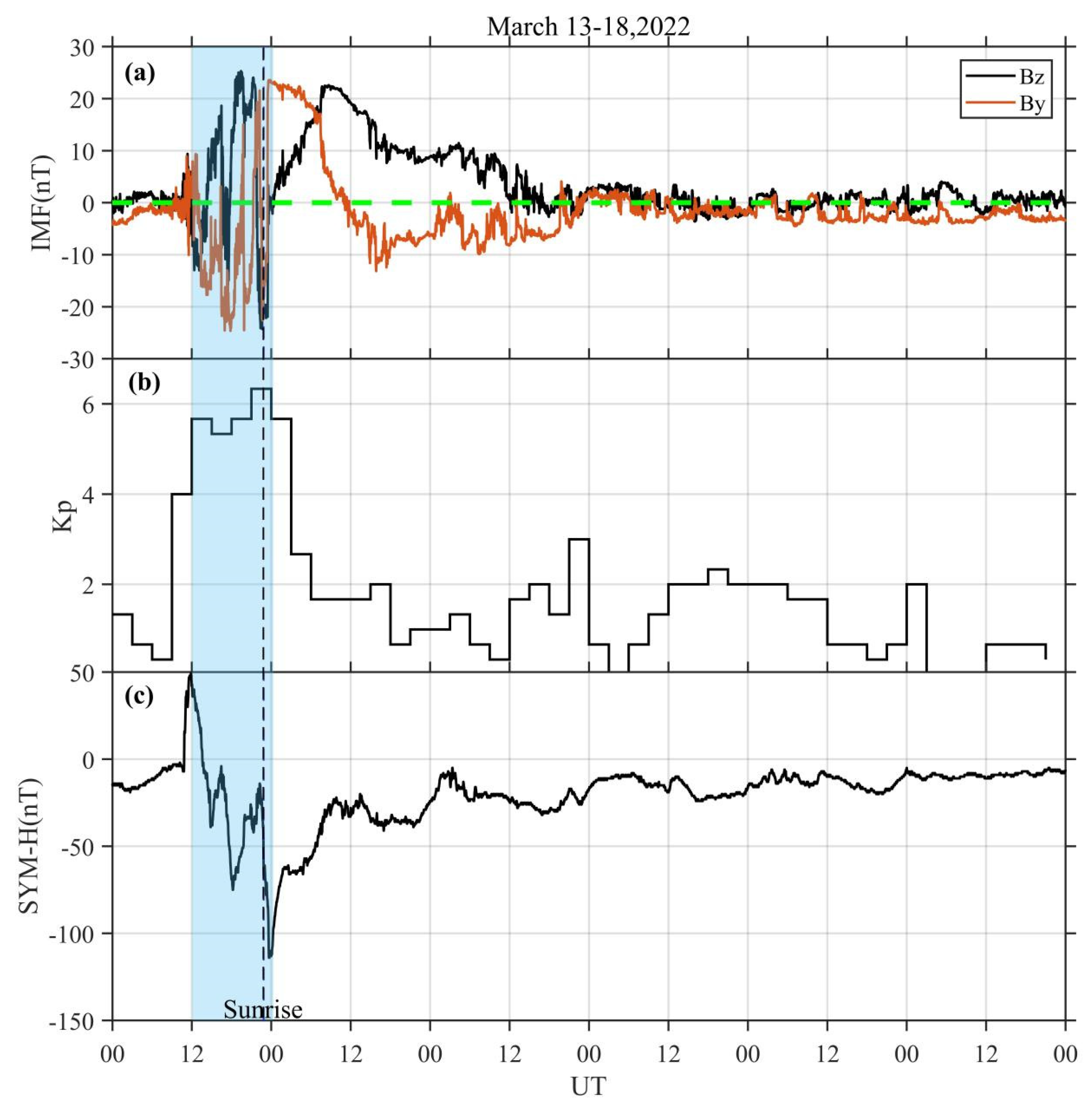
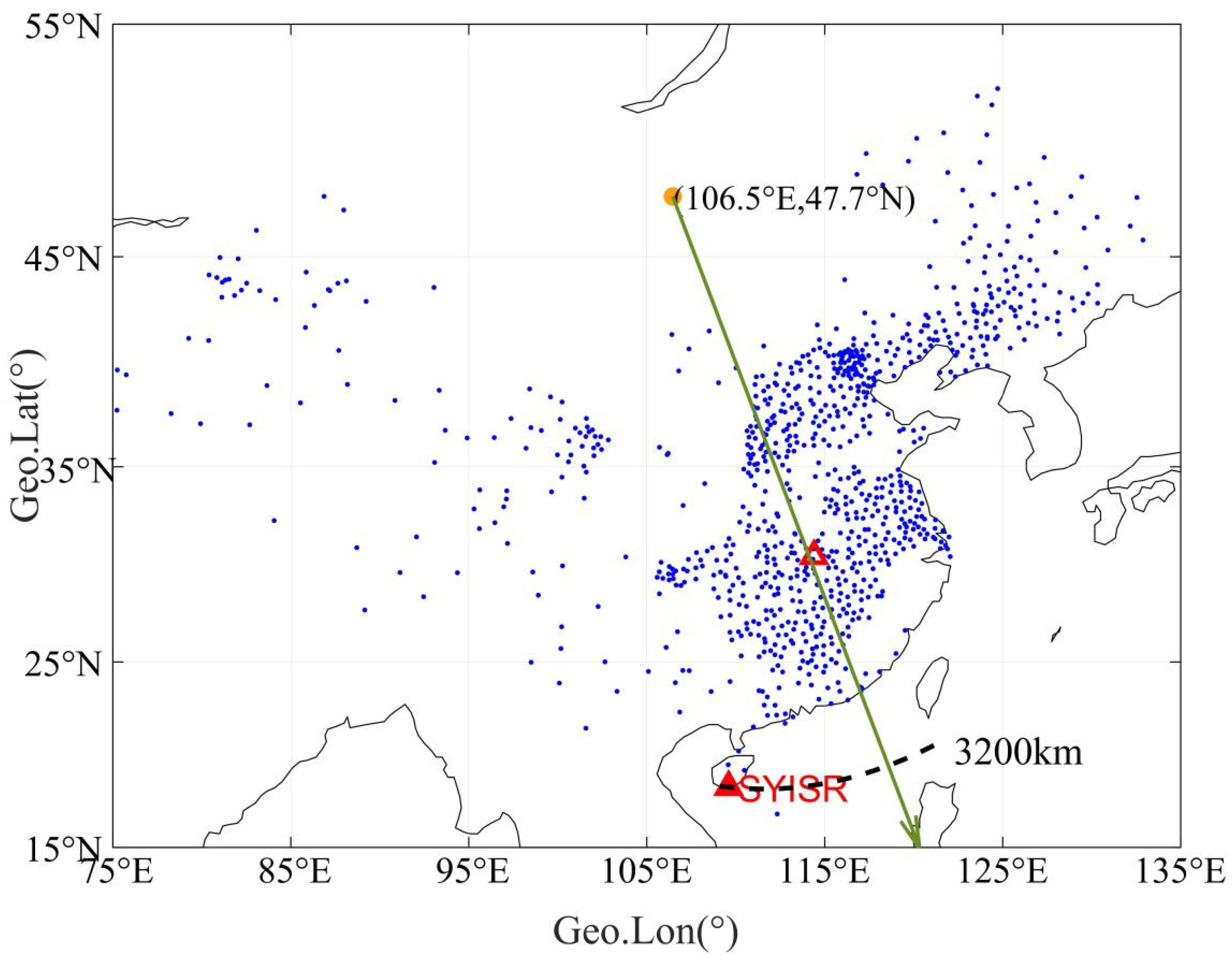
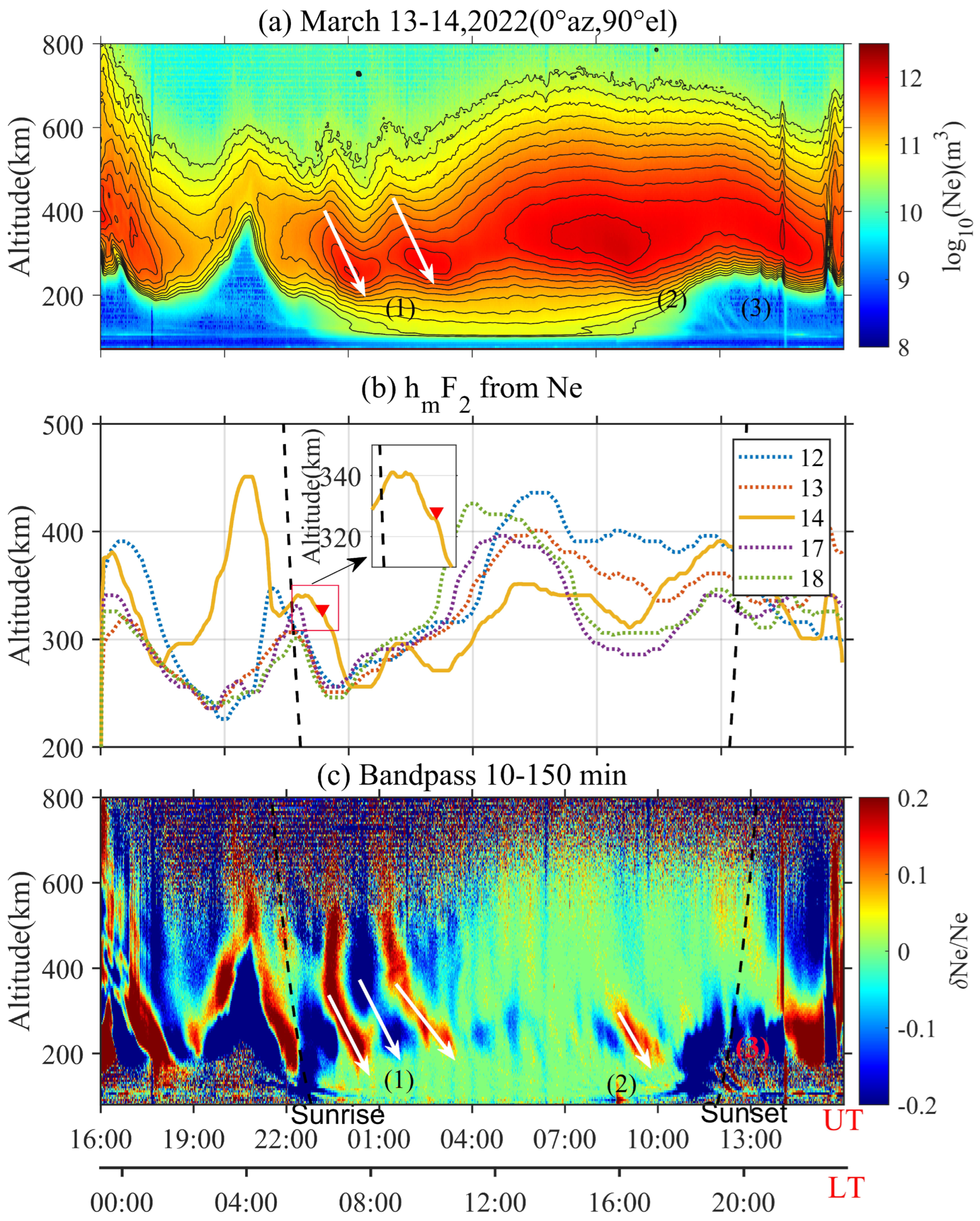
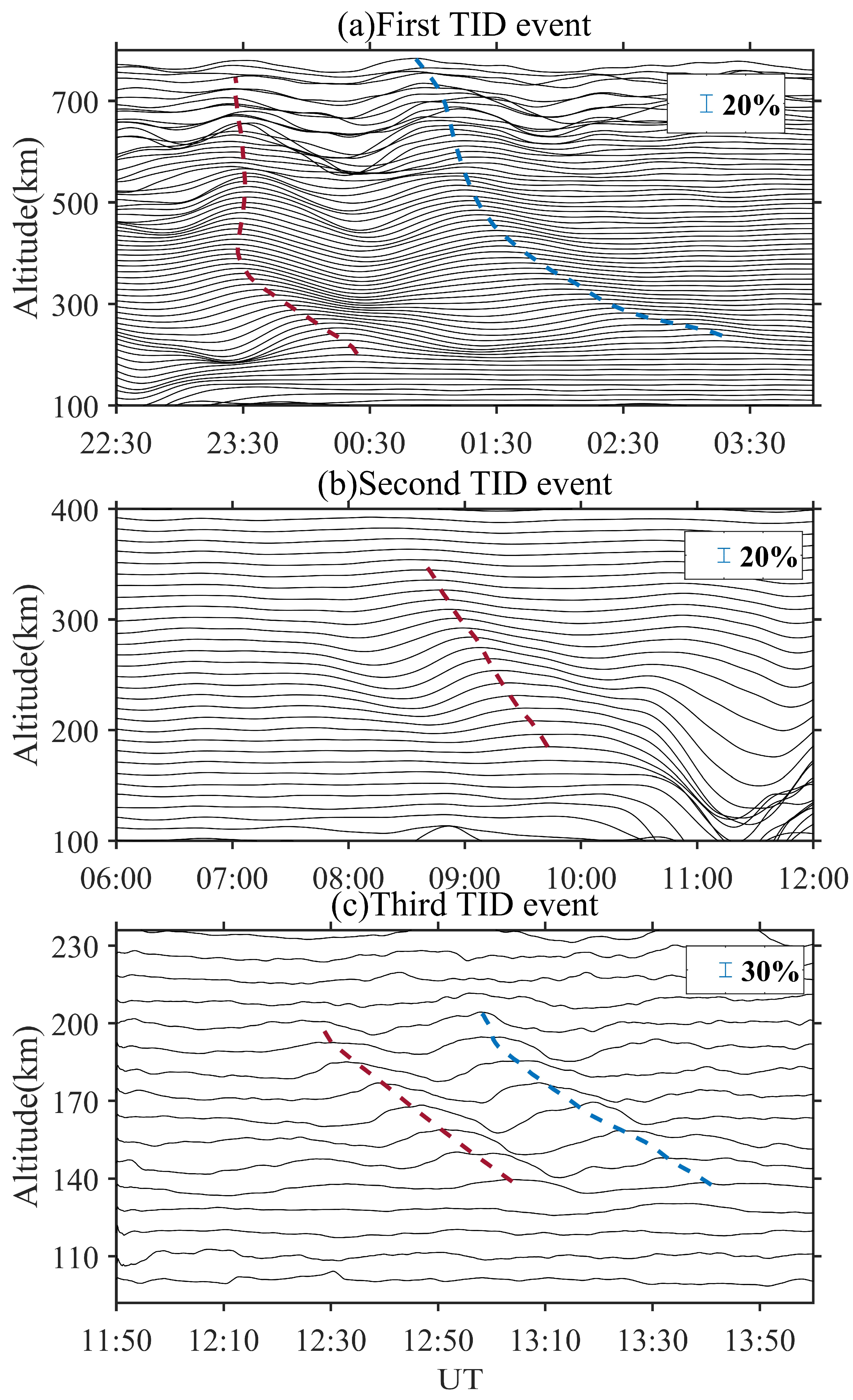
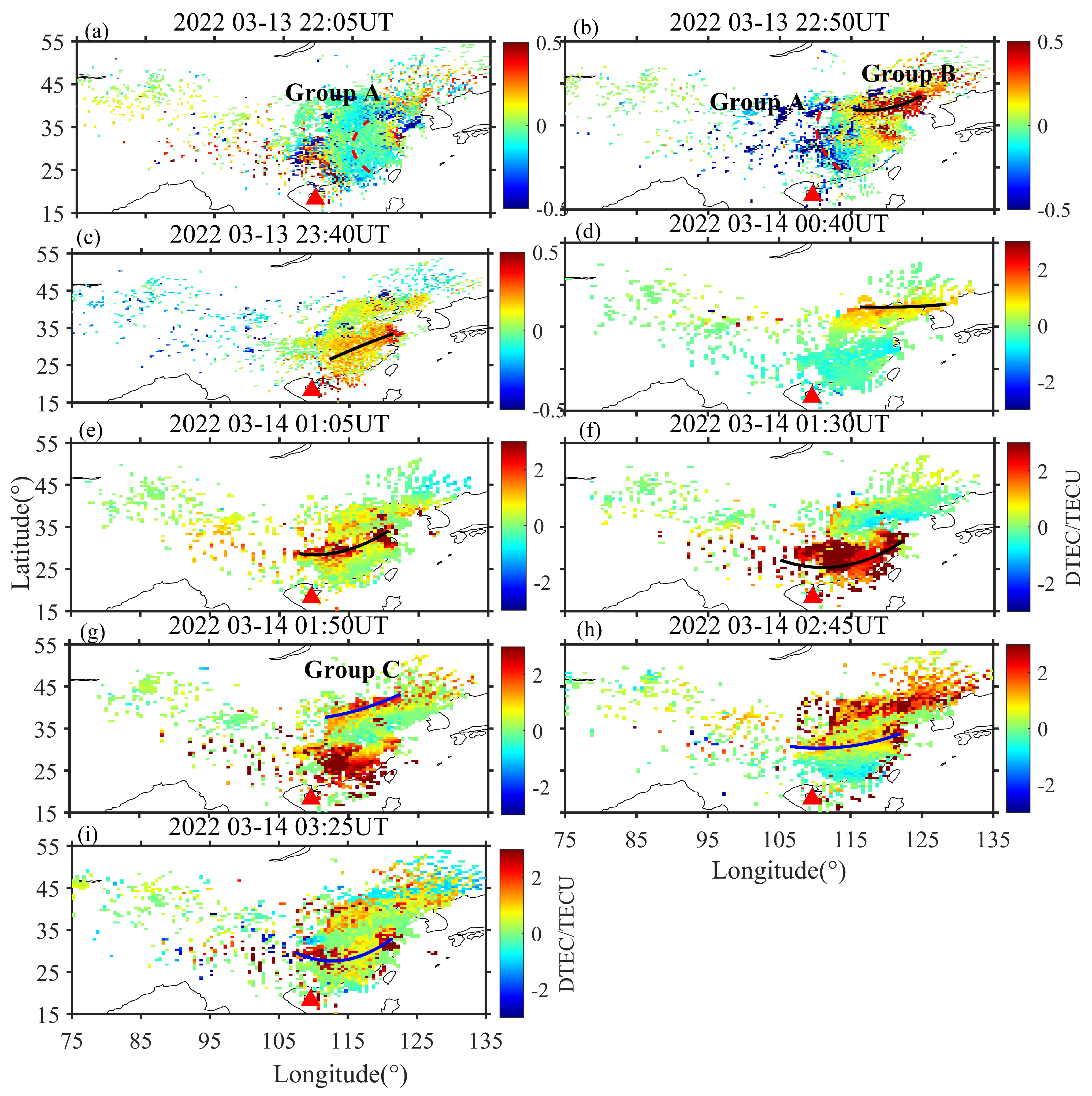

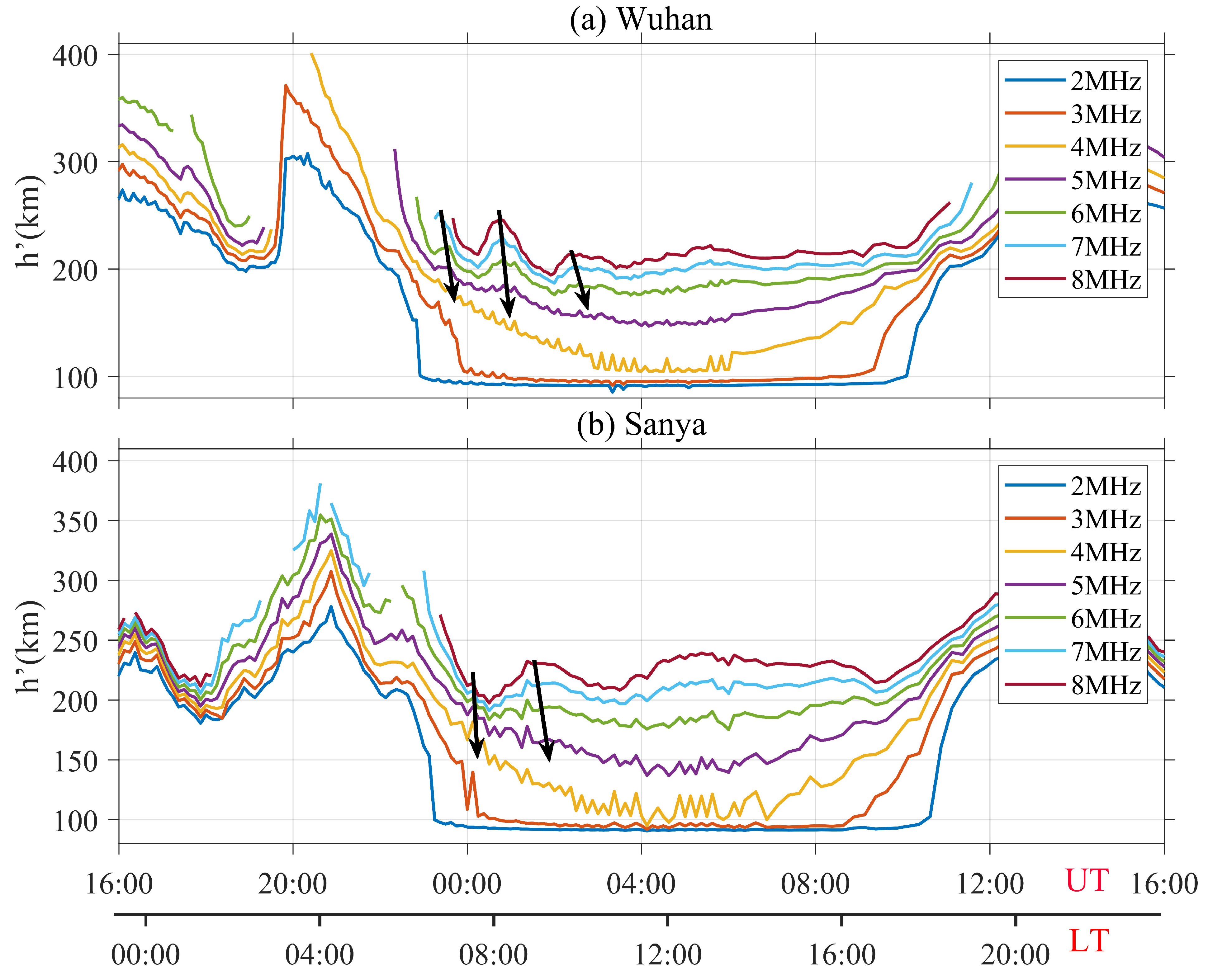
Disclaimer/Publisher’s Note: The statements, opinions and data contained in all publications are solely those of the individual author(s) and contributor(s) and not of MDPI and/or the editor(s). MDPI and/or the editor(s) disclaim responsibility for any injury to people or property resulting from any ideas, methods, instructions or products referred to in the content. |
© 2024 by the authors. Licensee MDPI, Basel, Switzerland. This article is an open access article distributed under the terms and conditions of the Creative Commons Attribution (CC BY) license (https://creativecommons.org/licenses/by/4.0/).
Share and Cite
Xu, S.; Ding, F.; Yue, X.; Cai, Y.; Wang, J.; Zhou, X.; Zhang, N.; Song, Q.; Mao, T.; Xiong, B.; et al. The Observation of Traveling Ionospheric Disturbances Using the Sanya Incoherent Scatter Radar. Remote Sens. 2024, 16, 3126. https://doi.org/10.3390/rs16173126
Xu S, Ding F, Yue X, Cai Y, Wang J, Zhou X, Zhang N, Song Q, Mao T, Xiong B, et al. The Observation of Traveling Ionospheric Disturbances Using the Sanya Incoherent Scatter Radar. Remote Sensing. 2024; 16(17):3126. https://doi.org/10.3390/rs16173126
Chicago/Turabian StyleXu, Su, Feng Ding, Xinan Yue, Yihui Cai, Junyi Wang, Xu Zhou, Ning Zhang, Qian Song, Tian Mao, Bo Xiong, and et al. 2024. "The Observation of Traveling Ionospheric Disturbances Using the Sanya Incoherent Scatter Radar" Remote Sensing 16, no. 17: 3126. https://doi.org/10.3390/rs16173126




